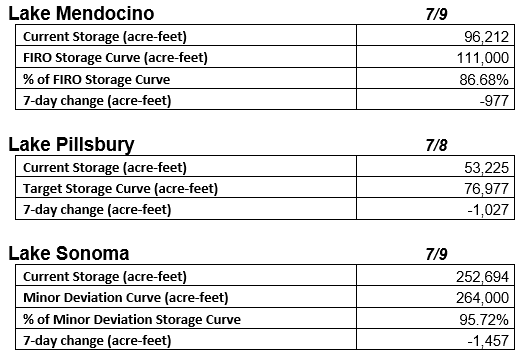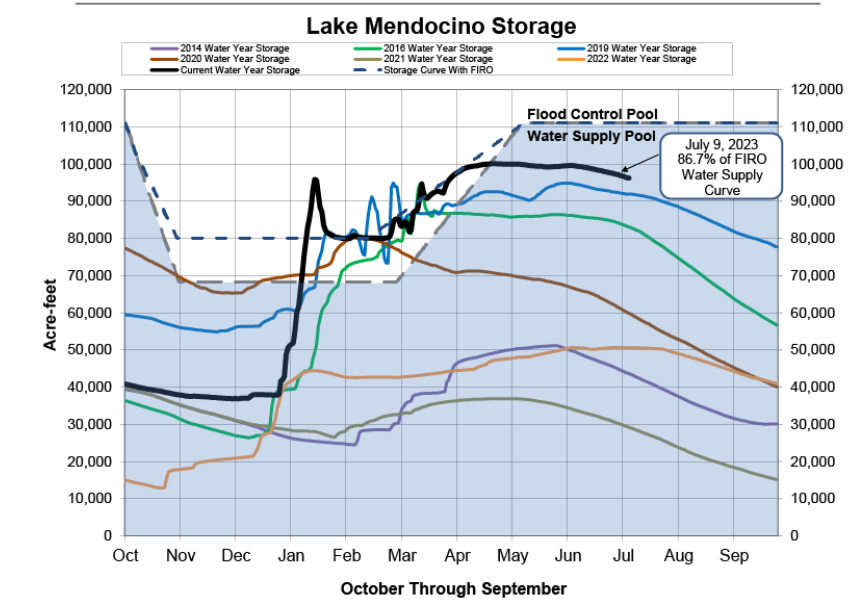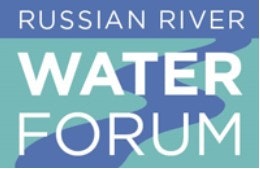Russian River Water Update, 7/10/23


Reservoir Storage & Operations:
Water supply information provided by Sonoma Water (more info here).



A Tale of Two Rivers
An engineering decision about a century ago twined together the fates of the Eel River and it southern neighbor, the Russian River, in ways that have made restoration efforts on the Eel particularly tricky today.
Read the full article: PPIC: Defining Community Is Slippery on the Eel River, 7/10/23



Russian River Water Forum Updates
The Planning Group meets this week, July 13, 2023, 10:00 am – 3:00 pm
Location: Ukiah Valley Conference Center and Zoom (Register here)
(https://russianriverwaterforum.org/)
Adapting to Weather Extremes: How the State Can Prepare for Drought in a Non-Drought Year; Water Commission to host three virtual public workshops in July

California’s changing hydrology has led to extreme weather patterns that affect the amount of rain and snow the state gets, impacting how we can capture and distribute water. Following three years of severe drought, California recently experienced a winter of extreme wet weather. Being able to endure the next severe drought is dependent upon making smart, preemptive water management decisions during non-drought years.
In support of Action 26.3 in California’s Water Resilience Portfolio, the California Water Commission is developing proposed strategies to protect communities and fish and wildlife in the event of drought, and is seeking public input at three virtual public workshops.
Workshop dates:
- Wednesday, July 19, noon to 3 p.m. – Register here
- Tuesday, July 25, 2-5 p.m. – Register here
- Thursday, July 27, 9:30 a.m. to 12:30 p.m. – Register here
At the workshops, participants will be asked to share drought impacts, discuss drought response, and provide feedback on four preliminary strategies:
- Increase Capacity and Information Needed to Manage Drought
- Scale Up Groundwater Recharge
- Conduct Watershed-level Planning to Reduce Ecosystem Impacts of Drought
- Better Position Communities to Respond to Drought Emergencies
“Small, rural communities and the environment are often hit the hardest during a drought,” said Commissioner Sandi Matsumoto, who also serves as director of the California Water Program at The Nature Conservancy. “In many places, water for fish and wildlife species is already severely limited in non-drought years. During periods of drought, water for the environment is even more drastically constrained.”
In addition to attending a workshop, the Commission encourages you to share your opinion in a drought strategies survey here. The survey will be open through July 12, 2023. For more information on the Commission’s work on drought, please visit: cwc.ca.gov/Water-Resilience-Portfolio.
Do you live, work, or own property in Northern California?
The California Wildfire and Forest Resilience Task Force’s Science Advisory Panel invites you to participate in a survey to understand stakeholder perspectives on improving ecosystem health and community resilience to wildfire in the Northern California region.
Read more here and take the 10-15 minute survey.
Addressing Nonpoint Source Pollution through EPA’s National Nonpoint Source Program Webcast
July 17th, 2023, 2:30 – 4:30 PM Eastern
Please join EPA’s Watershed Academy for this webcast to learn more about the national nonpoint source program and the various ways this program helps restore water quality across the United States.
Nonpoint source (NPS) pollution encompasses a wide range of sources and is the prevailing cause of the nation’s water quality problems. The vast extent and continuous nature of NPS pollution is a challenge that requires problems to be addressed through a variety of approaches using multiple funding sources. EPA’s national nonpoint source program encompasses a variety of initiatives and partnerships that help address NPS pollution in the nation’s waterbodies
Flood-MAR and FIRO come together for online workshop
The latest advancements in linking forecast-informed reservoir operations (FIRO) with flood-managed aquifer recharge (flood-MAR) will be discussed during an online workshop on Thursday, July 20. The agenda includes presentations on FIRO test sites and the tools available for reservoir operators to make forecast-informed decisions. There will also be a session on the work being done to identify FIRO-MAR opportunities and advance FIRO-MAR implementation.
In the press:
Grist: How the Western drought has increased carbon emissions, 7/20/23 “Hydropower loss added 121 million metric tons of carbon emissions over 20 years — about the same as putting 1.3 million more cars on the road.”
NorCal Water Insight: Keeping Up with Water Measurement and Reporting: A New Guidance for Water Suppliers and Landowners, July 2023 “With all the various water reporting and measurement requirements in California, it can be daunting to fully understand and then meet the various deadlines for reporting. A recent report authored by MBK Engineers summarizes and describes the current reporting and measurement requirements that water districts, companies, GSAs and individual landowners must comply. This report has been updated to reflect the most recent changes to reporting regulations….”
